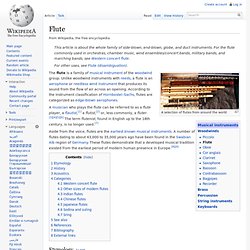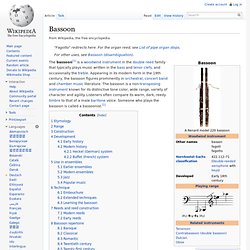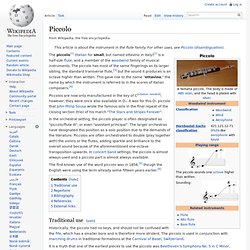

Recorder. From Wikipedia, the free encyclopedia Recorder may refer to:

Information About the Recorder Instrument. Flute. A selection of flutes from around the world A musician who plays the flute can be referred to as a flute player, a flautist,[1] a flutist,[2] or, less commonly, a fluter.[3][4][5][6] The term flutenist, found in English up to the 18th century, is no longer used.[7] Aside from the voice, flutes are the earliest known musical instruments.

A number of flutes dating to about 43,000 to 35,000 years ago have been found in the Swabian Alb region of Germany. These flutes demonstrate that a developed musical tradition existed from the earliest period of modern human presence in Europe.[8][9] Etymology[edit] The word flute first entered the English language during the Middle English period, as floute,[10] or else flowte, flo(y)te,[11] possibly from Old French flaute and from Old Provençal flaüt,[10] or else from Old French fleüte, flaüte, flahute via Middle High German floite or Dutch fluit. History[edit] Some early flutes were made out of tibias (shin bones).
Clarinet Facts for Kids. History of the Clarinet. Bassoon. The bassoon[1] is a woodwind instrument in the double reed family that typically plays music written in the bass and tenor clefs, and occasionally the treble.

Appearing in its modern form in the 19th century, the bassoon figures prominently in orchestral, concert band and chamber music literature. The bassoon is a non-transposing instrument known for its distinctive tone color, wide range, variety of character and agility. Listeners often compare its warm, dark, reedy timbre to that of a male baritone voice. Someone who plays the bassoon is called a bassoonist.[1] Etymology[edit] The word bassoon comes from French basson and from Italian bassone (basso with the augmentative suffix -one).[2] Range[edit] A1 is possible with a special extension to the instrument—see "Extended techniques" below. Interesting Facts About Bassoons. Bassoon. Bass oboe. The bass oboe or baritone oboe is a double reed instrument in the woodwind family.

It is about twice the size of a regular (soprano) oboe and sounds an octave lower; it has a deep, full tone somewhat akin to that of its higher-pitched cousin, the English horn. The bass oboe is notated in the treble clef, sounding one octave lower than written. Its lowest note is B2 (in scientific pitch notation), one octave and a semitone below middle C, although an extension may be inserted between the lower joint and bell of the instrument in order to produce a low B♭2. The instrument's bocal or crook first curves away from and then toward the player (unlike the bocal/crook of the English horn and oboe d'amore), looking rather like a flattened metal question mark[citation needed]; another crook design resembles the shape of a bass clarinet neckpiece.[1] The bass oboe uses its own double reed, similar to but larger than that of the English horn. Entry - Facts from the Encyclopedia on Yahoo! Kids. Piccolo Instrument Information. Piccolo.
The piccolo[1] (Italian for small, but named ottavino in Italy)[2] is a half-size flute, and a member of the woodwind family of musical instruments.

The piccolo has most of the same fingerings as its larger sibling, the standard transverse flute,[3] but the sound it produces is an octave higher than written. This gave rise to the name "ottavino," the name by which the instrument is referred to in the scores of Italian composers.[4] Piccolos are now only manufactured in the key of C[citation needed]; however, they were once also available in D♭. It was for this D♭ piccolo that John Philip Sousa wrote the famous solo in the final repeat of the closing section (trio) of his march "The Stars and Stripes Forever". In the orchestral setting, the piccolo player is often designated as "piccolo/flute III", or even "assistant principal".
The first known use of the word piccolo was in 1856,[5] though the English were using the term already some fifteen years earlier.[6] Traditional use[edit] Saxophone. History of the Saxophone - Adolphe Sax.